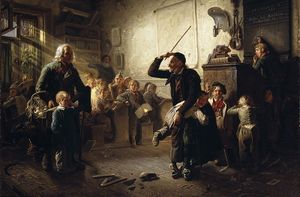Johann Peter Hasenclever
Johann Peter Hasenclever (born May 18, 1810 in Remscheid ; died December 16, 1853 in Düsseldorf) is one of the most important German painters of the 19th century. As a member of the Düsseldorf school of painting, Hasenclever was the founder of socially critical and ironic genre painting in Germany and, together with his Munich contemporary Carl Spitzweg, paved the way for Wilhelm Busch.
One of his preferred subjects were school scenes, of which he made at least 20 paintings since 1837. These range from lessons of a private tutor to rural school scenes. Several of these works depict the schoolmaster in the stereotypical situation of administering corporal punishment.
The humorous-satirical genre style of Hasenclever is reflected in the paintings of Carl Spitzweg and the drawings of Wilhelm Busch. Busch had met Hasenclever in Düsseldorf, and both artists worked on common material such as the Jobsiade.
Life
Hasenclever came from Remscheid in the Bergisches Land, where his father Johann Peter Hasenclever (1784-1864), a drill and small blacksmith, worked in the regional small iron trade. In 1825 he changed schools and moved into the house of his teacher Johann Peter Fasbender in Ronsdorf, who recognized and encouraged the fifteen-year-old's talent for drawing. Hasenclever painted two portraits of the Fasbender couple. At the age of 17 he transferred to the Düsseldorf Art Academy under its director Wilhelm von Schadow, but left her after just two years after Schadow expressed his doubts about the talent of the painting student. It was not until 1836 that Hasenclever made a second attempt and attended the painting class of Theodor Hildebrandt, who was inspired by Dutch painting of the 17th century to turn scenes from the everyday life of ordinary people, "genres", into pictorial subject matter. Genre painting was new artistic territory in Germany at the time. Johann Wilhelm Preyer and Hasenclever had been close friends since they were students.
Hasenclever achieved his first major successes in 1838 after moving from the Rhineland, accompanied by Preyer, to the art city of Munich, where he illustrated Carl Arnold Kortum's Jobsiade. In a short time, more than twenty paintings based on Kortum's satirical heroic story The Life, Opinions and Deeds of Hieronymus Jobs (an idle student who ends up as a night watchman) were created. King Ludwig I of Bavaria bought the painting Hieronymus Jobs im Exam in 1840.
When Hasenclever returned to Düsseldorf he was a well-known painter. In 1843 he was appointed a full member of the Berlin Academy of Arts. His painting technique was now mature and sovereign, he no longer limited himself to documentary depictions of everyday scenes, but strove to reveal the large and small weaknesses of bourgeois life in the Biedermeier period.
Hasenclever took part in the Vormärz political movement and was among the first painters in Germany to turn to socially engaged art. He became a member of the anti-academic artists' association Crignic, from which the Malkasten later emerged, and from 1847 he collaborated on the Düsseldorf monthly magazines. When the revolution finally broke out in 1848, Hasenclever stood up for the goals of a consistently democratic-minded citizen guard as deputy platoon commander. These goals were the provisional Lord Mayor of Düsseldorf, Joseph von Fuchsius, did not feel comfortable and he had the vigilantes monitored. In the same year, the paint box was founded as a reservoir for all democratic artists.
Hasenclever died of typhus at the age of 43.
Selected works (school scenes)
- Hieronymus Jobs als Schulmeister (1845)
- Der erste Schultag (1852), also known as Lasset die Kindlein zu mir kommen
See also
- Wikipedia article: de:Johann Peter Hasenclever (in German)
Links
Chat rooms • What links here • Copyright info • Contact information • Category:Root
